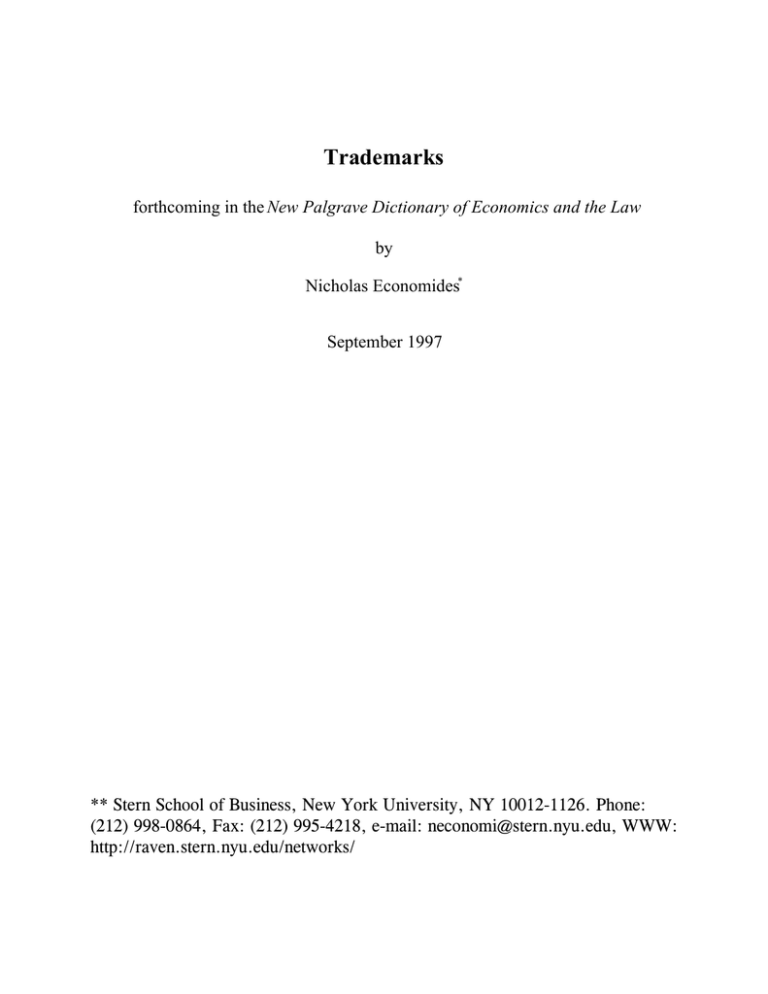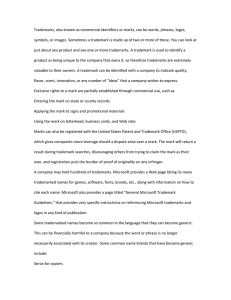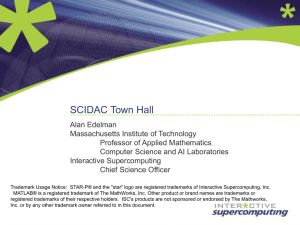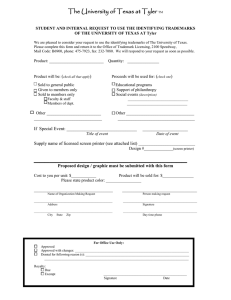Trademarks - NYU Stern School of Business
advertisement

Trademarks forthcoming in the New Palgrave Dictionary of Economics and the Law by Nicholas Economides* September 1997 **5VGTP5EJQQNQH$WUKPGUU0GY;QTM7PKXGTUKV[0;2JQPG (CZ GOCKNPGEQPQOK"UVGTPP[WGFW999 JVVRTCXGPUVGTPP[WGFWPGVYQTMU Trademarks A trademark or tradename is a legally protected name, word, symbol, or design (and their combinations) used by a manufacturer or seller to identify a product or service and distinguish it from other goods (see 15 U.S.C. section 1127). Similarly, a tradename is a legally- protected word or symbol that is used to identify a business entity. Typically, a trademark says little directly about the composition or specification of the good; instead, it identifies the maker of the good. The buyer infers information about the features of the good by remembering his/her previous experience(s). Similarly, the tradename of a company does not explicitly reveal information about the company. The tradename just identifies the company; consumers have to remember what the company produces, the reputation of its quality, etc. 1. Scope of Protection Trademarks are protected by the Federal Trademark (Lanham) Act of 1946 (see 15 U.S.C. section 1127). Many states offer some trademark protection within their respective boundaries through a registration process. Symbols, words or designs, upon being “trademarked,” become the property of the producer, under specified rules of use and abuse, and thereafter are part of the assets of the producer. The trademark holder is given a legal monopoly on the use of these trademarked symbols and names in connection with the attached commodity, and is exclusively protected against infringement. Similarly, the law allows a tradename to be registered and used exclusively by a business entity. Legal protection of trademarks is granted with respect to specified and related goods and does not extend to all products. For example, the trademark FORD owned by the automobile manufacturer does not cover unrelated items, say clothing. Thus, the same (or similar) trademark can be used by different owners in different product categories. Trademarks qualify for legal protection immediately upon use when they are “inherently distinctive.” For marks that are not “inherently distinctive,” the owner must establish a “secondary meaning” or “acquired distinctiveness” to receive legal trademark protection. Inherently distinctive trademarks fall into three types, “fanciful,” “arbitrary,” and “suggestive” trademarks. Fanciful trademarks are words that usually have no other meaning, such as EXXON. Arbitrary marks are words that have an inherent meaning, but have no apparent meaning when applied to the specific product, such as APPLE as applied to computers. Suggestive trademarks imply or suggest certain properties of the product to which they apply, such as FRIDGEDAIRE as applied to refrigerators. For suggestive trademarks the implied meaning is not immediate but requires mental effort by the consumer. Non-inherently distinctive trademarks are legally protected if they have acquired a “secondary meaning,” attesting to the mark’s acquired distinctiveness. Non-inherently distinctive trademarks may be surnames, such as MACY’S that have acquired a distinctiveness. They also may be geographically descriptive terms, such as MARLBORO, which have acquired distinctiveness and do not indicate the place of origin of a good. The existence of a “secondary meaning” must be proved as an association in the consumer’s mind between the trademark and the origin of the good. Marks that are merely descriptive terms for a good or its features or purpose do not qualify for legal protection. Legal protection of such marks would result in economic inefficiencies and social welfare losses, for the following three reasons. First, a descriptive term does not identify the good of a particular seller. Therefore a descriptive mark cannot properly perform the fundamental function of a trademark. Second, if the law gave monopoly rights to a term of general use by allowing it to be trademarked, the new “owner” of the mark would unfairly benefit from the value associated in the general pre-registration use of the word. Third, if a descriptive term were registered as a trademark, the rest of society, including competing firms would be deprived of the use of the term. In a similar vein, a design that is just “functional,” that is required for the good just to perform a certain function, does not qualify for protection, while distinctive designs, such as that of the COCA-COLA bottle can be trademarked. A “generic” term that just describes a class of goods is a primary example of a descriptive mark that cannot be trademarked. For example, the word BOOK cannot be trademarked. Often, the big success of certain brand names makes them vulnerable to becoming generic by describing a whole class of goods rather than the product(s) of a particular manufacturer. Famous examples of trademarks that became generic to the detriment of the original trademark owners include ASPIRIN, ESCALATOR, CELLOPHANE, and THERMOS. 2. Economic Function of Trademarks The primary reasons for the existence and protection of trademarks are that (1) they facilitate and enhance consumer decisions, and (2) they create incentives for firms to produce goods of desirable qualities, even if these qualities are not observable before purchase. Both of these effects are consequences of the fact that trademarks permit consumers to distinguish between goods which look identical in all features that are observable before purchase. The Senate Committee’s recommendation on the law that became the Lanham Act described the two purposes of trademarks as follows: “One is to protect the public so it may be confident that, in purchasing a product bearing a particular trademark which it favorably knows, it will get the product which it asks for and wants to get. Secondly, where the owner of a trademark has spent energy, time, and money in presenting to the public the product, he is protected in his investment from its misappropriation by pirates and cheats. This is the wellestablished rule of law protecting both the public and the trademark owner.” (S. Rep. No. 1333, 79th Cong., 2d Sess. (1946), reprinted in 1946 U.S.C.C.A.N. 1274) In many markets sellers have much more and better information about the unobservable features of a good for sale than buyers, i.e., there exists an informational asymmetry. Often, unobservable features are key determinants of the value of the good. Moreover, it may be easy to imitate to the last detail the observable features of a good, while significant differences remain in the features that are unobservable before purchase. In the absence of trademarks, consumers would often pick a good of undesirable qualities, while firms, unable to transmit to the consumer signals of the unobservable high qualities of their goods, would choose to produce goods with the cheapest possible unobservable qualities. However, when there exists a way to identify the unobservable qualities of a good at the time of purchase, consumers are facilitated in their choices, and firms have an incentive to cater to a spectrum of tastes for variety and quality. The economic role of the protected trademark is just that: to identify the unobservable features of the trademarked product, so that consumers are directly helped in their purchase decisions, and firms are indirectly prompted to produce what consumers truly desire. The trademark does not provide information in analytic form, such as a list of ingredients or indication of size or chemical composition. Instead, trademarks provide information in summary form, through a symbol which the consumer identifies with a specific combination of features. Information in analytic form is a complement to rather than a substitute for trademarks. Trademarks were originally used to identify makers of jewellery in the middle ages, although the craftsmen’s marks had been used since antiquity. Although the original intent was to identify the maker for possible fraud regarding the composition of the alloy, trademarks were soon used to identify the quality standards of particular producers. At present, besides its function in indicating the source of a product and its quality, a trademark identifies the product (the full combination of features that constitute the product). For example, the trademark DR. PEPPER identifies the particular kind of Cola drink. A tradename of a business entity can be used to attach a positive reputation of high quality to many products that this firm produces. Thus, there are typically increasing returns to scope in the use of a tradename. For example, given a valuable tradename in small cars, HONDA was able, over time, to use the same tradename for larger cars that it produces. However, given the association of a trademark with specific variety and quality features, it is sometimes not desirable for a manufacturer to use the same trademark in all its related goods. For example, Honda uses the name ACURA for its more luxurious models. Ralph Lauren, a clothes manufacturer, has three separate trademarks for its goods, stratified by quality: POLO, RALPH LAUREN, and CHAPS. 3. Degree of Success of the Economic Function of Trademarks For goods that are frequently purchased by the same consumer (experience goods) the degree of a trademark’s success depends on (a) the consumer’s ability to recall the mark and its associated features; (b) the inability of others to use a confusingly similar mark; and (c) the reluctance of firms to change the variety and quality features of the trademarked product. For goods that are infrequently purchased by the same consumer (search goods), tradenames may indirectly signal a quality standard extending to multiple products within a product category, or even to unrelated products that originate from the same firm. 4. Confusion and Dilution For the trademark to function effectively, it is necessary that there be no confusion in the minds of consumers about the source of the product. Thus, marks that resemble other trademarks are not allowed to be registered as trademarks if their use is “likely, when used on or in connection with the goods of the applicant, to cause confusion, or to cause a mistake, or to deceive.” (15 U.S.C. section 1052(d)) A different kind of infringement on a trademark may occur through “dilution.” Dilution does not necessitate the existence of likelihood of confusion among similar products, since dilution is relevant to use of the same mark in different lines of business. There are two types of dilution, “dilution by blurring” and “dilution by tarnishment.” Dilution by blurring occurs when a mark is used by a different manufacturer in an unrelated line of business. For example, the trademark XEROX would be diluted if it were used by a manufacturer of chairs. Dilution by tarnishment occurs when the mark is used by a different seller in unrelated goods that are of lower quality than those of the trademark holder. Dilution by blurring prevents consumers from identifying a trademark or a tradename with a particular good or collection goods, thereby diminishing the effectiveness of a trademark. Dilution by tarnishment does not allow the information about the quality level of the trademarked good or collection of goods to be correctly inferred. Thus, dilution interferes with the proper economic function of trademarks. 5. Possible Distortionary Effects of Trademarks Some distortions may result from the introduction of trademarks. Trademarks make perception advertising possible. Through perception advertising, a desirable mental image may be added to the quality and variety features of a trademarked product, permitting competition in yet another dimension. The tie-in of the objective attributes of the product with the ones attached to it through perception advertising may distort purchasing decisions. Moreover, resources are wasted in the effort to link desired mental images with advertised goods. Other distortions may also occur from opening competition in a new dimension (see Economides (1986)). These potential distortions are generally expected to be small and outweighed by the benefits of the use of trademarks, described earlier. The legal protection of trademarks may also create a distortion through the awarding of exclusive monopoly rights in the use of certain words, symbols, or designs that are “trademarked.” The law has provided insurance against such potential distortions through the exclusions of generic and descriptive names from trademark protection (See section 14(c) Lanham Act, 15 USC §1064(c), and §15(4) Lanham Act, 15 USC §1065(4)). Not only is the protection of merely descriptive names limited under the Lanham Act, but also designations that, in the eyes of the relevant public, primarily come to denote a product category rather than the product’s producer cease to be valid trademarks. 6. Summary In summary, trademarks play an indispensable role in the efficient provision of experience goods that have the variety and quality features consumers desire. A similar role is played by trademarks in upholding the quality level of infrequently consumed goods. Trademarks make perception advertising possible and therefore can result in anticompetitive distortions associated with perception advertising. Moreover, the legal monopoly on the use of names that are trademarked also creates a potential distortion. However, both of these distortions are expected to be small, and are unlikely to outweigh the benefits of the efficient provision of variety and quality benefits that trademarks facilitate. References Statute Trademark Act (1946), 15 USC §§1051-1127, (Lanham Act). Bibliography Economides, N. 1988. The Economics of Trademarks. Trademark Reporter 78: 523-539. Landis, W. M. and R. Posner 1988. The Economics of Trademark Law. Trademark Reporter 78: 267-306. Schechter, F. 1925. The Historical Foundations of the Law Relating to Trade-Marks. New York: Columbia University Press.




